(Written by Maxx)
If you love LEGO and are a fan of LEGO colors, you’ll love “Bayer test-strikes” or simply called “Bayers”. You may want to read my previous article titled LEGO Colors – Introduction to familiarize yourself with the history of LEGO colors, and in today’s article, we will focus on some very unique bricks in LEGO’s history. So lets start from the beginning…
➡ 1958: LEGO has a bit of trouble with the CA plastic; it’s tough and colorfast, but it warps over time – not a good thing for a product that has a reputation of being precise. Trying to find a solution LEGO contacts Bayer, a very large plastics-supplier in Germany.
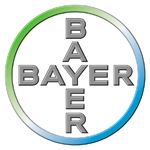 Bayer is asked by LEGO (around 1960) to make them a better plastic; non-warping, flexible but also rigid, color fast and the lot. Bayer is up for the job and gets to work. To be able to decide whether the plastics work, they get a few of LEGO’s older molding machines with 2×4 brick-molds. Bayer starts to make test strikes.
Bayer is asked by LEGO (around 1960) to make them a better plastic; non-warping, flexible but also rigid, color fast and the lot. Bayer is up for the job and gets to work. To be able to decide whether the plastics work, they get a few of LEGO’s older molding machines with 2×4 brick-molds. Bayer starts to make test strikes.
These test bricks were meant to be used only in conversations and briefings between Bayer and LEGO. But some of them “escaped” – factory workers took them home for their kids to play with, others were simply put in boxes, stashed away until someone took them home.
Meanwhile Bayer continued to test colors as well. Many of these colors were tried and produced, but never made it to the public until a quarter century later (or never at all). We know of some of these colors from postcards of tan pyramids in the 60s, green bricks in the early 70s and dark gray even before light gray existed.
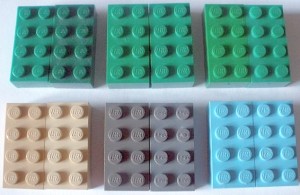
These colors where made for the LEGOLand parks, but also for product lines such as Modulex. Modulex comes in colors not seen in LEGO for a long time or at all. But we do have Bayers test bricks in those colors!
➡ 1960 to 1975: This is by far the most interesting time to collect 2×4 bricks from! They have beautiful colors with the old LEGO logo – colors that might never be used again. Or colors you might only know from certain small parts – like trans-black, trans-blue or Maersk blue – long before the color was used in a brick!
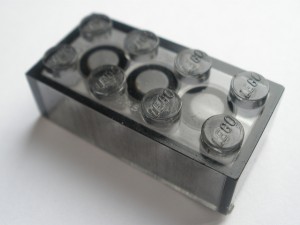
The next important step was to decide which grip (clutch) to give the bricks. These became known as the A,B,C,D tests. Through a contact with a LEGO representative I have had a confirmation on the grip-tests done with the A,B,C an D coded bricks.
His words: “The story I have been told is that four different bricks with different clutch-power were made. And Ole Kirk (or maybe Godfred) had to decide which one was best. He decided for the brick with the letter C and since that time the C-norm brick has been our reference brick.”
This C-norm is the grip (clutch) that our bricks have right now. And when this C-norm is established, Bayer gets molds with a C on each stud where the LEGO logo normally is. These are now called 8xC bricks and still come in a lot of colors, but are clearly more modern colors. 8xC bricks feature amongst others, the first Pearl-light-gray bricks. These bricks also have numbers on the bottom: 03, 05 or 06.
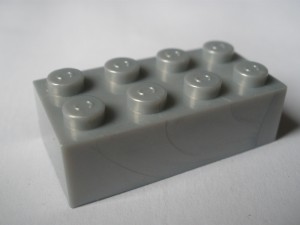
After this it gets a bit confusing. There is some time period overlap; colors and letters on the bricks switch between 7xC and 8xF. The only way to determine when a certain brick was made might be through color matching with real LEGO colors.
7xC comes in the most colors (after the original LEGO Bayer), and most of these colors are found in sets (though not all in 2×4 bricks). We find nice pinks and purples from the LEGO for girls sets, also light-gray and light-bluish-gray, as well as several different blues and greens.
In addition a lot of marbled bricks come in 7xC which I haven’t seen in any 8xC brick.
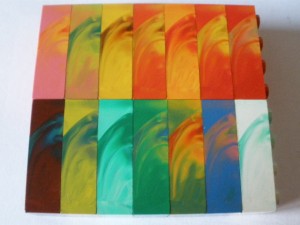
Besides Bayers from Germany there are also a few test bricks known from England, see the marbled red/whites below. These were made by British LEGO Ltd. in Wrexham Wales, so they should be named Wrexhams.
The 8xF bricks are found in two forms (actually 3, but I’ll discus those later), normal 8xF and 8xF with one F like a little flag. I believe these to be a simple molding fault, but I know collectors that collect both. 8xF bricks do not come in many colors like the 7xC, but feature more “normal” LEGO colors. This is logical as these were made in the late nineties, when LEGO downsized colors. They do have tan and light orange amongst their palette.
There are many tiny differences in the LEGO Bayer bricks over the years, not only in the letters, like LEGO or A, but also in Pat.Pend or simply the bottom design. I have bricks with closed studs (open studs were invented to prevent the stud from collapsing), side pips, top pip and even bottom pips.
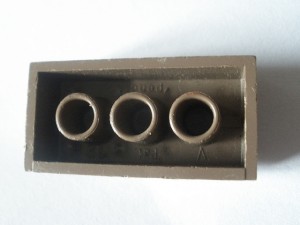
After years of leaking out of the Bayer plants, some of these LEGO Bayer bricks found their way in to my collection and I got fascinated with them; their beautiful colors, old logos, new logos, letters, everything! Trying to find more has led me on a trip around the world! And they seem to turn up everywhere! But no country has more to offer than Germany, the Bayer home-base.
After many years of collecting Bayers, I have made numerous contacts, loads of friends and fellow collectors; and they all help me find new items. Also, having collected more than one of each part, I am able to trade with other collectors, helping them make their collection bigger.
Like with any other collection, the fun is in the hunt for new parts! Once found, you catalog them, make pictures, share with others, and put them in their final resting place – your collection.
Right, I promised to tell about the third 8xF LEGO Bayer brick, so here it goes. Besides the “normal” Bayers, some extraordinary ones turn up at times. Amongst those are the 8xF with a block-letter F instead of the normal slanted F. Also amongst these are 7xC1 bricks with LEGO on the eighth stud. Or the other way round; 7xLEGO with one letter on the eight stud.
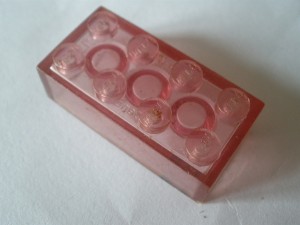
Even after all these years, I still find new LEGO Bayer bricks never before seen by the public. I try and show them to all who want to see them, on BrickLink, Brickshelf and Flickr. If you are interested or simply wish to know more, try “Bayer”, “LEGO” and “letter” on your search engine.
And you might also like to check out the following related posts:


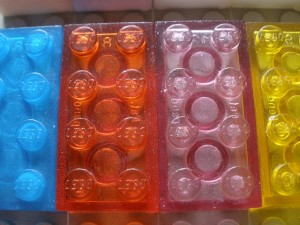
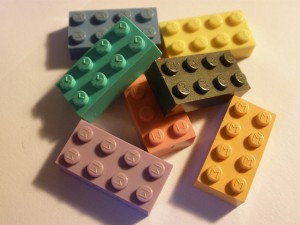
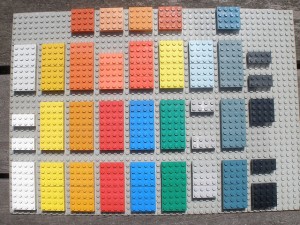
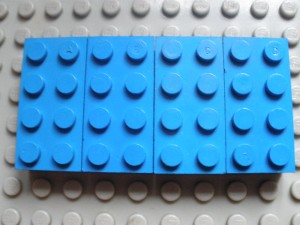
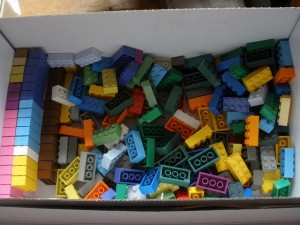
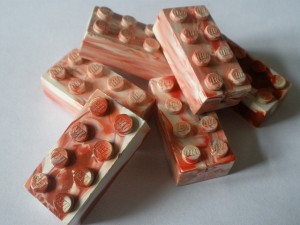
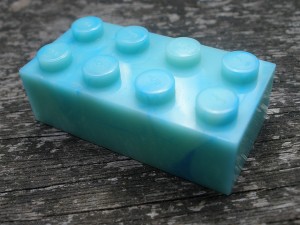
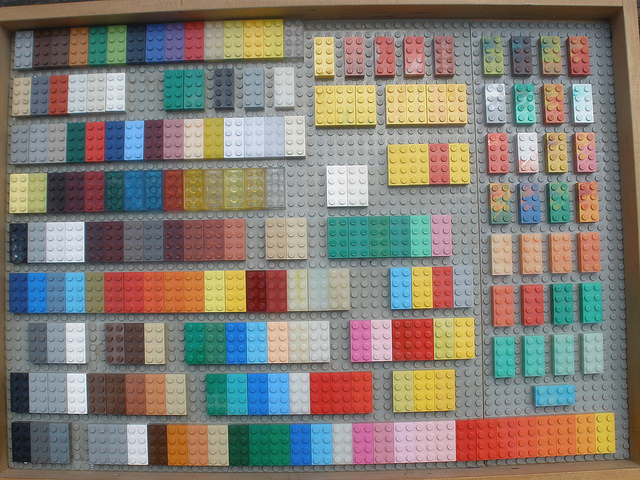










Fascinating, thank you!
I have never seen anyone take such great pictures of simple bricks! Your devotion to collecting them obviously shows! Great post! Very inspiring for collectors!
@Kingcobra: Thank you for your kind words, they really made me smile:)
Excellent article! posting to my facebook page now…
I agree on the photography! I mean look at that blue brick! It almost has a mystical aura! Maxx’s magic bricks! LOL!
Have you found any bricks with the A, B or D clutch? If so, how are they different? Taller studs? Ridging?
Very fascinating article! Thanks for sharing your collection.
@Will, yes, the A,B,C and D bricks are all out there, I have all in many different colors.
Below the A,B,C and D part, you see a picture with small rows of color, 4 if I have all A,B,C and D (click on the picture to enlarge it).
An empty space for the letter that’s missing.
@Morningcoffie, Thank you, you guys make me blush (c:
Maxx, you’re talking about this picture, right?
https://www.flickr.com/photos/maxx361/
@Eric, yes, thank you Eric:)
Also, to answer the question from Will, There are NO differences in the A,B,C and D bricks, apart from their grip/clutch.
A is very loose and will fall of if simply lifted.
D grip needs both hands and sometimes even a knife (ouch!!!)
Thanks, now I know how to look at the picture. And this selection of bricks already gives me ideas for building with them. Of course, the collector in me doesn’t want to use them since they’re a piece of history. And the builder in me says, “A bricks for destructible elements and D bricks for keystones!”
Those marbled bricks are pretty, especially the red/white ones. Those would make nice, um, bricks (in a house)! 🙂
@slovakiasteph, yes they probably would! 🙂
Hé, that’s not my comment……
But marbled bricks are almost all beautifull(c:
Wait a minute!!! Are we having two Maxx-es here???!!! 😯
Now, that is interesting! Well, nice have you both! 😆
(I told you Maxx; get a Gravatar, otherwise readers won’t be able to identify you! Now there is even more reason for that! 😉 )
Anna, I have the purple square behind my post, the other poster has a green one:)
Strange………
Maxx, the “other Maxx” has a different email address and IP address than yours. That is why the square a different color. If you recognize the comment as yours, the only possibility is that you have left that comment with a different email address from a different location. (Although this is unlikely as I just checked the IP address and it indicates a different continent than yours.) I hope this won’t cause you an identity crisis! 😕
If the “other Maxx” reads this, maybe you can help “our Maxx” to solve this mistery? 😉
Thank you for sharing with this info…
It is very useful to a newbie in LEGO colour bricks….
Your collection is truly superb…
I know I can never have what you have, so, will follow-up closely on your blog to keep me updated with the new fascinating colour bricks that you find.
LEGO… PLAY ON
Hi Chris,
Although it’s hard to find lots of these colors, you could start with just a few.
There are some on BrickLink, some for small prices.
But I also just started with only a few colors.
Or simply only buy the “normal” LEGO 2×4 brick colors, or like Anna here does, collect 2×2 brick colors.
Enjoy(c:
Thank you for your encouragement & advice, Maxx.
I like the way of your colour brick catalogue
In fact, I’m collecting only the ‘normal’ brick colours, 2×4, 1×1 & 2×2 (ranked by priority). Those ‘bayer’ bricks are really beyond my reach…
Personally, I like 2×4 the most as I feel that it is the most iconic part for LEGO.
Ask Anna for my mail, send me a message and your address and I will send you a few Bayers(c:
Thank you in advance.
I’ve asked Anna for your email.
Let’s chat more via emails later.
Chris, I have sent you Maxx’s email address. If you like, please share pictures of your color collection! We would love to see it! 😀
Maxx, you can also direct readers to your profile (under the Contributors tab). Your email contact link is there. 😉
Thanks for the history lesson, explanation and pics!
You are welcome, I have found out a lot more since I wrote this part(c:
It’s time for an update…
Maxx, looking forward to it! 😉
I’m trying to find a marbled Lego brick to purchase. Any tips?
Zeke, contact Maxx. He has tons of them, and he is also happy to sell or trade. His marbled LEGO collection is amazing! Here is his store: http://www.bricklink.com/store.asp?p=maxx3001. It is currently closed, but you can contact him through his store tab. Tell him I sent you and he will help you out. 😉